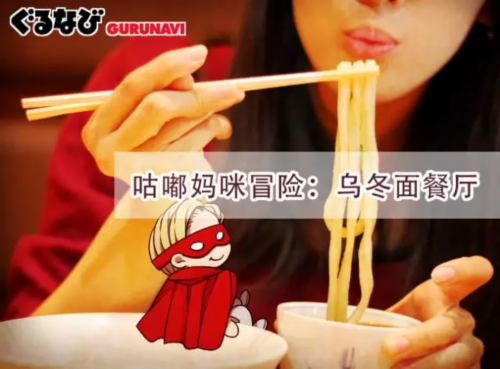
Six forms of udon noodles
Udon noodles, there are countless ingredients and decorations to match. But what most people don't know is how udon noodles are cooked before they are paired with ingredients and garnished.
1. Clear noodle soup
The first is clear soup noodles, which are made by adding warm udon to warm broth. For clear noodle soup, boiling noodles is a very critical step, after cooking the noodles, quickly filter them with cold water, then blanch the noodles with hot water, and finally add to the Kansai fish soup stock.
What is Kansai Fish Soup Stock?
Kansai fish soup stock is a clear soup made from kelp seaweed, dried fish, mushrooms, and soy sauce. This style of soup is popular in Kansai (around Osaka). The Kanto fish soup broth, on the other hand, focuses on the spices extracted from bonito and seasoning, and replaces a small amount of soy sauce with a constant amount of soy sauce.
2. Kamaage udon noodles
The second is kamage udon, which is also a warm udon, except that the noodles need to be dipped in soy sauce sauce to taste. Kamaage udon noodles are served in a bowl with soup and another bowl with fragrant fish soup. This type of udon noodles is very different from the general udon in terms of eating.
Because the freshly cooked udon noodles in kamaage udon have never been filtered with cold water, the taste will be very unique.
3. Yudame udon noodles
The third is yudame udon, which is also a warm udon that needs to be dipped in sauce to taste. Yudame udon is very similar to kamaage udon, but there is an important difference in the cooking process. Yudame udon noodles are made by filtering the cooked noodles in cold water and then warming them up with hot water before they are served. The extra step of filtering the noodles with cool water makes the yudame udon not only taste good, but also very chewy.
4. Bukkake udon noodles
The fourth is bukkake udon, which is available in both cold udon and hot udon, and is eaten with a cold sauce. Cold bukkake udon noodles are made by filtering the cooked noodles in cold water, placing them in a large bowl and pouring them into the noodles with a fragrant fish broth. Warm bukkake udon noodles are based on the cold bukkake udon noodles production method, with an extra step: the cold water filtered udon is filtered again with hot water.
5. Kama-bukkake udon noodles
The fifth is kama-bukkake udon, which is also divided into two types: cold udon and warm udon, which is eaten directly with a cold sauce. Kama-bukkake udon differs from bukkake udon in that it has an extra step: the cooked noodles are not filtered with cold water. Kama-bukkake udon has a taste similar to kamaage udon.
6. Shippoku udon noodles
The sixth is shippoku udon noodles, which are served warm udon noodles in a warm broth. In some parts of Japan (such as Kagawa Prefecture), shippoku udon is made by boiling it and filtering it in cold water before putting it in the fish soup broth. Fish broth, on the other hand, is made from radish, carrots, taro, potatoes and other root vegetables.
How to eat udon noodles
In Japan, the uncontrollable sound of sipping when eating any noodles (except Western pasta) is forgivable, but this is a bad habit overseas. The reason why Japanese people silp very loudly is because this not only helps them eat cold noodles faster, but also adds auditory stimulation to eating!
Choose the right Udon shop
In Japan, there are several ways to decide where to eat Udon. But the focus is on what type of ambient atmosphere you want.
Sit down at the Udon Hotel
Like a normal restaurant, after being seated by the service staff and then providing you with a menu, order food according to the menu.
Self catering Udon Hotel
This type of shop depends on how many services you want to get. In other words, the service provided by each store is different. Some restaurants even let you dig up some vegetables from the backyard garden yourself, or let you chop up the raw materials you want to use yourself.
In Tokyo, Japan, the most common cafeteria is for you to grab a plate, order the udon noodles you want from the chef, and wait. But while you're waiting, you can grab some tempura or other dessert sauce as a pre-dinner snack.
Udon Factory Hotel
Not all shops that sell udon make their own, which means there must be udon factories. These factories provide tables for everyone to sit down and eat freshly processed udon noodles. Eating udon noodles at an udon factory may sound strange, but it's unforgettable as soon as you eat them. Freshly processed udon noodles taste very different from the usual udon, but it is worth mentioning that after all, this is only a factory, if you want to eat udon noodles here, then you may need to bring your own chopsticks, bowls and soy sauce.
How to order udon noodles like a local
The following words are often used when pointing udon noodles. Most of these words can be used to explain to the chef the temperature of the noodles and broth you want.
atsu atsu: Both udon noodles and soup are hot
Atsu hiya: Udon noodles are hot, but the soup is cold. (This combination isn't very popular, perhaps because many people prefer chewy noodles.) However, some people who don't like hot noodles may prefer this type. )
hiya atsu: Udon noodles are cold, but the broth/juice is hot. (People living in Kagawa Prefecture prefer hiya atsu.) This combination of udon noodles makes it easier to enjoy the tendons of the noodles and the rich flavor of the broth. )
hiya hiya: Both udon noodles and soups are cold.
sonomama: Udon noodles are cooked without filtering with cold water.